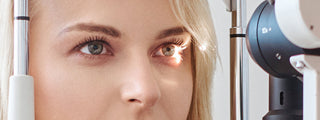There are numerous eye diseases and vision problems. Some are untreatable, but many others can be prevented or treated.
According to Statistics Canada, 5.5 million Canadians (1 in 7) live with a life-threatening eye disease.
About 1 in 4 school-aged children suffer from a vision problem. That makes vision loss one of the top ten causes of disability in Canada for adults and one of the most prevalent conditions in children.
The Good News is that it's never too late to start taking care of your eye health.
Routine
eye exams can lead to early detection, which is the key to preventing, correcting, or delaying most eye conditions.
The five most common eye conditions leading to vision loss or blindness are Refractive errors, Macular Degeneration, Cataracts, Diabetic Retinopathy and Glaucoma.
However, there are hundreds of other eye diseases and disorders.
1 - Refractive Errors
Refractive errors represent the most common eye conditions in Canada.
Refractive errors include:
Myopia is an imbalance between the length of the eye and the curvature of the cornea or lens; as a result, when viewed at a distance, the image appears blurry as it focuses in front of the retina. In contrast, an image viewed up close is clear.

Hyperopia is a refractive disorder that requires the eye to make an accommodation (focusing) effort to avoid seeing blurred images, which can require a lot of energy from the visual system.
Astigmatism is caused by an eye whose surface is not perfectly rounded, which results in the distortion or stretching of images perceived from far or near.
Presbyopia, a typical process related to the eye's aging, progressively sets in around 45. There is no way to prevent this vision disorder.
Refractive errors can be corrected with eyeglasses, contact lenses or, in some cases, surgery.
2 - Macular Degeneration

Macular Degeneration, often called age-related Macular Degeneration (AMD), is a multifactorial disease associated with age, which gradually destroys the macula, responsible for the vision of details.
It is the leading cause of vision loss in those over 60.
There are two forms of AMD: Wet and Dry.
Bleeding, leakage and scarring from these blood vessels cause damage and rapid central vision loss.
An early symptom of wet AMD is straight lines that appear wavy. Wet Degeneration can sometimes be treated with a laser.
Intraocular injections can also limit the proliferation of blood vessels, but they must be repeated regularly.
These treatments do not usually restore lost visual acuity, but they do slow down the progression of the disease.
There is no treatment for the atrophic form of Macular Degeneration.
However, new studies show that vitamins and antioxidants and omega-3
supplements can slow the progression of the disease.
Symptoms to watch for: blurred or distorted central vision.
3 - Cataracts
A cataract is a clouding of the lens of the eye.
It is the leading cause of blindness globally and the leading cause of vision loss in Canada.
Cataracts can occur at any age due to various causes and can be present from birth.
Although treatment for cataract removal is widely available, barriers such as insurance coverage, cost of treatment, patient choice or lack of awareness prevent many people from receiving appropriate treatment.

4 - Diabetic Retinopathy
Diabetic Retinopathy (DR) is a common complication of diabetes.
It is the leading cause of blindness in American adults. It is characterized by a progressive deterioration of the blood vessels in the retina, the light-sensitive tissue at the back of the eye that is necessary for good vision.
Diabetic retinopathy usually affects both eyes.
The risk of DR is reduced by managing the disease, including reasonable control of blood glucose, blood pressure and lipid abnormalities.
Early diagnosis of DR and timely treatment reduce the risk of vision loss;
however, up to 50% of patients do not have their eyes examined or are
diagnosed too late for treatment to be effective.
DR also increases the risk of retinal detachment.
Glaucoma affects about 2% of the population over the age of 40.
It is an attack on the optic nerve that is generally caused by high pressure
inside the eye. This pressure is often related to difficulties in draining one of
the eye's liquids, the aqueous humour.
This pressure can damage the optic nerve and cause gradual and
irreparable vision loss when it becomes significant.
Consult your eye care professional promptly if a vision problem develops or
worsens.











